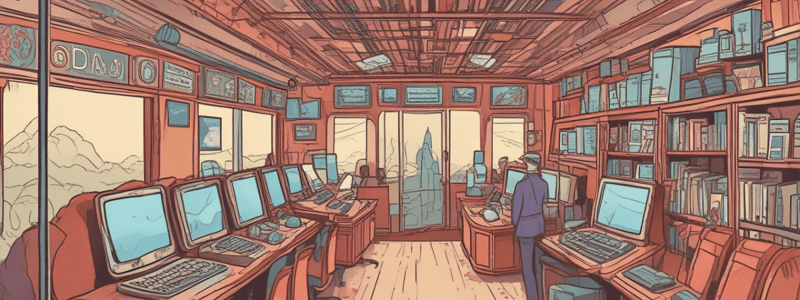Podcast
Questions and Answers
What is the primary function of distribution channel members?
What is the primary function of distribution channel members?
- To promote products through advertising
- To manage inventory and logistics
- To provide customer service
- To overcome time, place, and possession barriers (correct)
What type of flow involves the movement of products from the company to the consumer?
What type of flow involves the movement of products from the company to the consumer?
- Forward Flow (correct)
- Backward Flow
- Reverse Flow
- Bidirectional Flow
Which of the following is an example of a Zero-Level Channel?
Which of the following is an example of a Zero-Level Channel?
- Manufacturer sells directly to a customer through telemarketing (correct)
- Manufacturer sells to a wholesaler
- Distributor sells to a retailer
- Retailer sells to a consumer
What is the term for the chain of intermediaries or processes through which products or services reach the end consumer?
What is the term for the chain of intermediaries or processes through which products or services reach the end consumer?
Which of the following is an example of a Three-Level Channel?
Which of the following is an example of a Three-Level Channel?
What is the primary goal of marketing channels?
What is the primary goal of marketing channels?
What is the primary objective of evaluating different channel alternatives in marketing?
What is the primary objective of evaluating different channel alternatives in marketing?
What is the key benefit of a Vertical Marketing System?
What is the key benefit of a Vertical Marketing System?
What is the primary difference between multichannel marketing and omnichannel marketing?
What is the primary difference between multichannel marketing and omnichannel marketing?
What is the primary reason for conflict in a channel system?
What is the primary reason for conflict in a channel system?
What is Service Process Design in marketing?
What is Service Process Design in marketing?
What is the primary consideration in selecting channel members?
What is the primary consideration in selecting channel members?
What is the primary goal of managing variability within a service process?
What is the primary goal of managing variability within a service process?
What is the primary determinant of service quality, according to the Service-Quality model?
What is the primary determinant of service quality, according to the Service-Quality model?
What is the primary focus of the 'People P' of the marketing mix?
What is the primary focus of the 'People P' of the marketing mix?
What is the primary purpose of service recovery?
What is the primary purpose of service recovery?
What is the primary characteristic of 'Moments of Truth' in service encounters?
What is the primary characteristic of 'Moments of Truth' in service encounters?
What is the primary goal of managing technology-supported interactions in service delivery?
What is the primary goal of managing technology-supported interactions in service delivery?
What is the primary function of physical evidence in a service experience?
What is the primary function of physical evidence in a service experience?
What model is often discussed in connection to store atmospherics?
What model is often discussed in connection to store atmospherics?
Which of the following senses is NOT directly involved in perceiving the store atmosphere?
Which of the following senses is NOT directly involved in perceiving the store atmosphere?
What is the primary goal of designing a store atmosphere?
What is the primary goal of designing a store atmosphere?
Which dimension of the store atmosphere is concerned with the softness, smoothness, and temperature of surfaces?
Which dimension of the store atmosphere is concerned with the softness, smoothness, and temperature of surfaces?
What is the term for the process of designing buying environments to produce specific reactions in consumers?
What is the term for the process of designing buying environments to produce specific reactions in consumers?
What is the term for the five basic tastes that can be influenced by the store atmosphere?
What is the term for the five basic tastes that can be influenced by the store atmosphere?
Flashcards are hidden until you start studying
Study Notes
Physical Evidence and Atmospherics
- Physical evidence refers to the surroundings or environment where a service takes place, including physical or tangible items supplied during the service experience.
- It provides a visual metaphor for an organization's total offering and can act as a facilitator or differentiator.
Store Atmospherics
- Store atmospherics involve designing buying environments to produce specific reactions in consumers, increasing purchase propensity and other shopping responses.
- The atmosphere is understood through the senses, including sight, sound, scent, touch, and taste, and can serve to attract attention, act as a message medium, and elicit emotions and cognitions.
Sensory Marketing
- Sensory marketing involves using the senses to create a specific atmosphere and influence consumer behavior.
- The four dimensions of sensory marketing are visual, auditory, olfactory, and tactile.
Distribution Channels
- A distribution channel is the chain of intermediaries or processes through which products or services reach the end consumer.
- Distribution channels can include wholesalers, retailers, distributors, self-service kiosks, email, call centers, direct sales forces, and digital platforms.
Channel Members
- Channel members play a crucial role in overcoming time, place, and possession barriers that separate products and services from consumers.
- The key functions of channel members include forward flow, backward flow, and bidirectional flow.
Channel Levels
- Channel levels refer to the number of intermediaries involved in the distribution process, including zero-level (direct sales), one-level (one intermediary), two-level (two intermediaries), and three-level (three intermediaries) channels.
Channel-Design Decisions
- Channel-design decisions involve analyzing customer needs and wants, establishing objectives, identifying major channel alternatives, evaluating alternatives, and selecting channel members.
- Marketers must consider factors such as lot size, waiting and delivery time, spatial convergence, product or service variety, and service back-ups when designing a distribution channel.
Service Process Design and Management
- Service process design involves describing and prescribing the procedures to be followed in service delivery.
- There are four core aspects to consider in service process design: the degree of technology used, the degree of visibility, the degree of customization, and the degree of accessibility.
Managing Variability
- Variability in service process design can be managed through accommodation, which allows variability in customer requests, and reduction, which reduces variability and gets the customer to accept this.
Service Quality
- Service quality is determined by five factors: reliability, responsiveness, assurance, empathy, and tangibles.
- The zone of tolerance refers to the range of customer perceptions of a service between desired and minimum acceptable standards.
Service Recovery
- Service recovery involves responding to service failures and taking actions to avoid or address the failure, mitigate decreased customer confidence and loyalty, and make the customer satisfied again.
People Management Challenges
- The People P of the marketing mix focuses on relationships and human interactions and should be designed to make the service experience pleasant and satisfactory.
- Moments of truth, which are critical to customer loyalty, require superb handling and customer-centric behavior from frontline employees.
Managing Technology-Supported Interactions
- Service encounters involve interactions between technology and humans, and managing these interactions is critical to ensure that technology does not damage or become a barrier to interpersonal relationships.
Training Service Personnel
- Training service personnel involves creating an environment where they can behave in accordance with the brand image of the service provider and provide authentic expressions and emotions.
Managing Physical Evidence and Experience Environment
- Managing physical evidence and experience environment involves creating an environment that is consistent with the brand image and provides a satisfactory service experience.
Studying That Suits You
Use AI to generate personalized quizzes and flashcards to suit your learning preferences.




